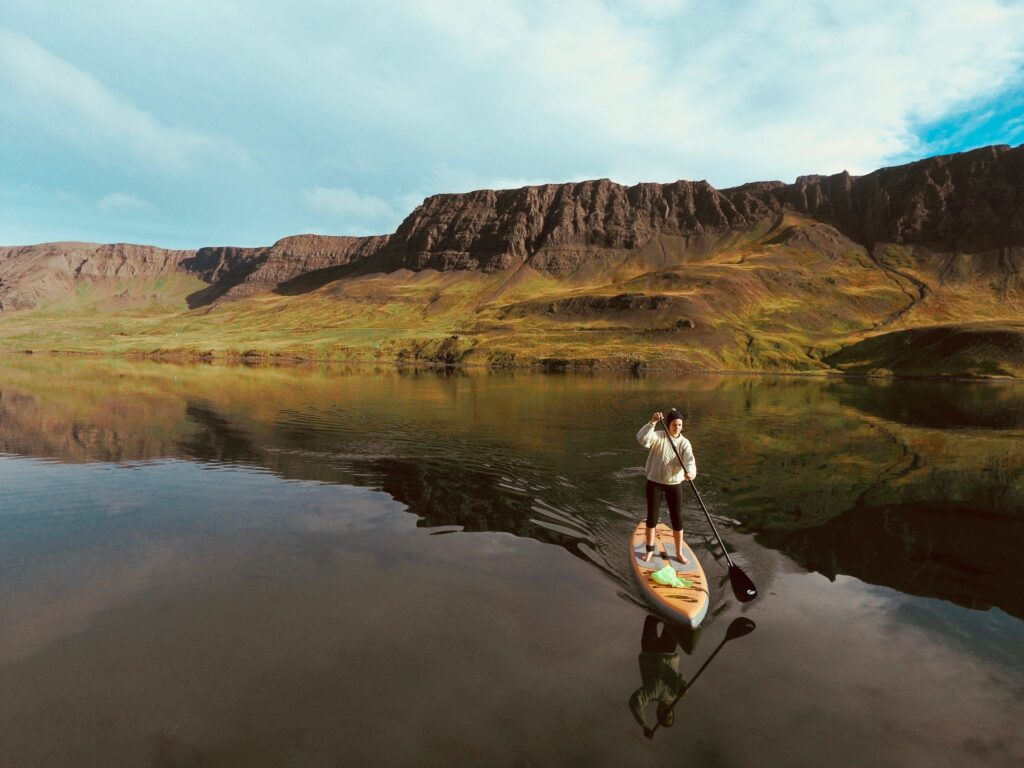
BOOT & FUN Berlin 2024 – We are exhibiting!
Hamburg, 17.11.2024 – After successfully participating in surf festivals in the north of Germany (Fehmarn) and a trade fair in the south,
Do you finally want to start Stand Up Paddling, but don’t yet have an idea on how to go about it properly? Which SUP equipment is relevant? You simply feel overwhelmed by the many possibilities this sport has to offer. Are you despairing at the sheer number of board types on various manufacturers’ websites? Many newcomers feel the same way. Here you get a good overview of SUP equipment. Additionally, you will receive tips that will make it easier for you to get started in the world of Stand Up Paddling.

First of all, you should think about your SUP equipment. Stand Up Paddling, not only includes a board and paddle, but also a few accessories. In addition to the fin and a leash, a life jacket should also be included if necessary. Furthermore, you don’t just want to look good on the water, you also want to be adequately protected from the weather and cold water. Choosing the right clothing on the board is therefore also very important.

Let’s start with the board. Before making the purchase, you should ask yourself how you will transport your equipment to the water and what the storage options are.
If you generally have a space problem, then the inflatable version (iSUP) is the best option. When rolled up, it takes up no more space than a conventional travel bag and can be inflated to the prescribed pressure (usually 15 – 20 PSI) using an air pump. Depending on the degree of hardness, standing on an iSUP feels a bit like standing on a trampoline. The higher the quality of the iSUP, the more you will feel like standing on a real hardboard. When storing, you should consider that an iSUP is subjected to material stress over time due to creases etc., while rolled up. If you do not use the iSUP for a longer period of time, you should inflate it to about half the prescribed pressure. If possible, store the iSUP in a horizontal position with sufficient air circulation, in a place protected from the sun. If you can only store the iSUP rolled up, always make sure that it is dry. It is best to roll it up loosely so that the air can circulate between them to some extent.
If space is only a minor consideration for transportation or storage, a hardboard could also be chosen. The advantages of a hardboard clearly lie in its gliding properties in the water. On the one hand, the stiffness of the material means you have more direct contact with the water and can really feel the water beneath you when paddling. Secondly, you are simply faster with a hardboard than with an iSUP. Furthermore, hardboards are precisely shaped for the corresponding conditions, have clearly defined edges and specially shaped hulls depending on the area of use. iSUPs, on the other hand, have clear limits in terms of shape. Although there are now also special models of iSUPs in the all-round and touring segment that can be used for performance-oriented wave riding or racing, they do not come close to hardboards in terms of performance.
In addition to hardboards for waves and racing, I also have an iSUP (Red Paddle Explorer in 13.2 feet) in my garage, which I recently used to paddle a longer tour on a reservoir lake. This board glided calmly through the water at around seven kilometers per hour. Standing on the slightly springy deck, I felt as safe as on a raft.

If you live inland and rarely or never paddle on the sea, then I recommend an all-round board with touring characteristics and plenty of volume. To start with, it can have at least twice as much volume in liters as your body weight in kilograms. So if you weigh 80 kilograms, your first all-round board should have a volume of at least 160 liters. If you live on the coast and occasionally want to surf a few waves while standing, then at the beginning, you should get an all-rounder with wave-riding capabilities. Depending on how ambitiously you want to surf the wave, you will certainly want to reduce the volume quickly.
For my first SUP, I personally opted for a 10.6-foot-long surfboard with a volume of 160 liters. I still have this board, and whenever I’m at the coast and find waves, I still enjoy taking it out on the water.
A used SUP board could be a very interesting way to get started with the basis for your SUP equipment at a reasonable price – see another Stoked Zone blog “Used surfboards and surf equipment” under SUP.


In the next blog, I’ll give you a few tips on what you need to drive forward. Finding the right paddle is not difficult if you keep a few things in mind. More tips on SUP equipment will follow.
Your Timmi!


Hamburg, 17.11.2024 – After successfully participating in surf festivals in the north of Germany (Fehmarn) and a trade fair in the south,

Hamburg, 10.12.2024 – Boot & Fun Berlin was another success for the development of the Stoked Zone as a platform for surf sports

Hamburg 25.11.2024 We are very pleased to announce our partnership with the premium surfskate brand Curfboard.Curfboard is a German company with a